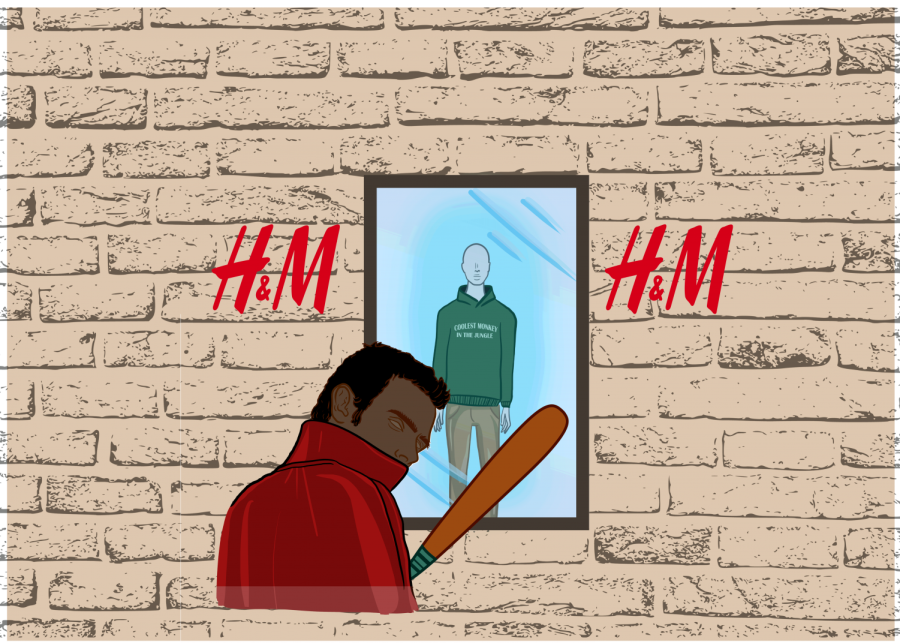Use of violence in H&M proves counterproductive
March 1, 2018
An online advertisement released by H&M on Jan. 8 featured a young black boy modeling a sweatshirt with “Coolest Monkey in the Jungle” embroidered on the front. The Swedish clothing giant immediately received backlash across social media, with critics denouncing the photograph and accusing the advertisement of having underlying racial undertones. Response to the photo eventually escalated into violent uproar, with demonstrators from South Africa’s second-largest opposition party, Economic Freedom Fighters (EFF), organizing protests at stores at the Menlyn Park Shopping Center in Pretoria. Video clips of the activists destroying displays, kicking over clothing rails and knocking down mannequins surfaced soon after the protests. While the protesters’ anger in regard to the degree of ignorance and insensitivity expressed by H&M is justified, demonstrations should adopt a more peaceful approach to better reflect their causes.
Within a week of the advertisement’s release, EFF protesters in South Africa led a violent uproar on Jan. 13 through six H&M stores in Gauteng Province, near Johannesburg, the economic hub of South Africa. The EFF protesters, part of a revolutionary socialist political party, trashed the H&M stores and were eventually dispersed by rubber bullets fired by police officers. EFF’s leader, Julius Malema, explained that the rationale for targeting H&M was that the brand had “called our children baboons.” At the rally, Malema told the crowd that that they were teaching the company a lesson — to not reject or humiliate African customers based on skin color.
As the photograph of the boy and sweatshirt continued to circulate over social media, H&M was quick to undertake damage control, immediately removing the photo from its website and the product from all stores. Many celebrities, particularly those of African descent, took to Twitter to express their disapproval with the brand and its method of advertising. H&M apologized for its negligence and assured that investigations would be held to uncover the reasoning behind the marketing decision. The retailer has also since hired a diversity leader to prevent future incidents of a similar nature.
Though it is possible that the advertisement may not have been intentionally racially offensive, it was nonetheless ignorant, and H&M’s cultural naivete should not be overlooked. Its comparison of black people to monkeys is animalizing, and this styling decision is an instrument in dehumanization. At the same time, the H&M protests should have been carried out in a more civil manner to develop a more coherent message to maximize its effect. A good example of a more effective form of protest is the Women’s March, a passionate yet peaceful rally that garnered significant attention and amassed the largest single-day participation for a protest in U.S. history. As a result of the march and its endurance, women developed a growing interest in the political climate, and a Women’s March was held again the following year. Although many different causes were advocated for, the peaceful nature of the event gave protesters an umbrella cause to fight under, offering visibility to a variety of issues including reproductive rights and equal pay.
“The Women’s March was really effective because it was able to gather a large number of people united under a certain cause,” said sophomore Sarah Sotoudeh, vice president of Intersections, a social justice club on campus. “It shows just how many people care about a topic and are willing to put their time and energy into participating.”
Adding the element of violence to resistance can often jeopardize protesters’ causes. Violent protesters are more likely to engage in spontaneous and brutal tactics, such as property destruction, which can potentially deprive them of any sympathy or support. As a result of the EFF’s actions, many individuals, particularly South Africans, are split on whether or not to support it. While most understand the group’s original motive, they are hesitant to offer their support because the violent situation has emerged as a battle of evil against evil.
“Violent protests are controversial, and people may think H&M is undeserving of the violent protests,” said junior Selena Jeong, public relations officer of Intersections. “So, in turn, it may impact the way people view the original issue; it shifts the focus from H&M’s crude advertising to the violent retaliations of the protesters.”
Particularly problematic is the fact that the employees of the H&M stores that were destroyed are mostly of African descent, and are the ones responsible for cleaning up the mess and repairing the damage. They might eventually be put out of work as many H&M stores in South Africa were forced to close as a result of the protests. Vandalizing stores, and thereby threatening the jobs of many black employees, does little to mitigate the racism expressed by the corporation, let alone uproot it. The issues can be tricky when reflecting on a history of numerous failed attempts by marginalized populations to challenge discrimination. But likewise, history has frequently shown that violence only perpetuates further violence. Defacing property is a superficial solution to an issue as entrenched as institutional racism, and such actions pose a threat to the stability of existing movements working to eradicate it.
“The violent protests were not justified,” said Jeong. “As a company, [H&M] would likely listen to the public outrage that ensued promptly afterwards. I understand the protesters’ anger, and their anger is perfectly valid. However, I believe violent protests should be used sparingly, and I don’t believe the H&M incident was deserving of one.”
Protests today play a pivotal role in fighting social injustice, and the racist advertising of H&M is unquestionably an issue that should be challenged. The approach of the EFF protests involving the vandalizing and defacing of H&M stores in South Africa, however, is ultimately counterproductive. These violent methods foster even more criminality in a movement that is already targeted for lack of civility. Rather than resort to violence, the protests should employ more appropriate procedures that strengthen and garner support for their cause without threatening those affected by the very racism they oppose.




























































